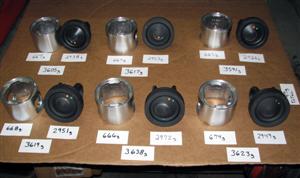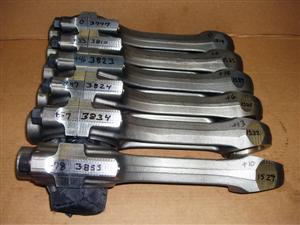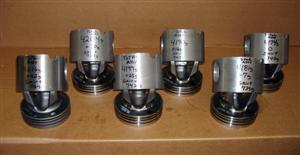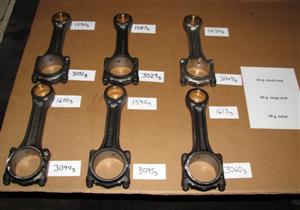April 2010 - Performance Zone
GET THE BALANCE RIGHT
By Performance Specialist Bruce C. Mallinson
Today, we are going to get technical about the balancing of diesel engine pistons and connecting rods. If you have been reading my articles, you already know we won’t build an engine without balancing the rods and pistons. We have been doing the balancing since we started the Signature Series engine program a year ago. Many years ago, we used to balance the Big Cam Cummins rods and pistons, but somehow we got away from it with the electronic engines.
 Over the years, talking with owner operators daily on the phone and at truck shows, it became apparent to me that there was a balance problem with the new electronic engines. The engines I am referring to are the 1992 and newer models. This balance problem is so bad on a few trucks that the driver’s hands go numb holding the steering wheel. When an engine is assembled with pistons and rods this far out of balance, nothing can be done on the outside of the engine to correct the problem. Many shops will change the driveshaft angle, install new injectors, replace the crankshaft damper, replace hoses, and replace fuel filter heads, but none of these things will work. The weight of the pistons and connecting rods are just too far off (unbalanced).
Over the years, talking with owner operators daily on the phone and at truck shows, it became apparent to me that there was a balance problem with the new electronic engines. The engines I am referring to are the 1992 and newer models. This balance problem is so bad on a few trucks that the driver’s hands go numb holding the steering wheel. When an engine is assembled with pistons and rods this far out of balance, nothing can be done on the outside of the engine to correct the problem. Many shops will change the driveshaft angle, install new injectors, replace the crankshaft damper, replace hoses, and replace fuel filter heads, but none of these things will work. The weight of the pistons and connecting rods are just too far off (unbalanced).
 Years ago, when we raced small block Chevys, the “pink” rods we used were about 8 grams out of balance, so we balanced them to be exactly the same weight. On today’s 12 to 19 liter diesel engines, we strive for the pistons and rods to be within 8 to 10 grams of each other. Many times we find the pistons are 80 grams out and the rods are as much as 110 grams out! And, as you can see in the pictures, the rods are out on the wrist pin end, too. So, not only do the rods need to weigh the same, but the rod bearing end and the wrist pin end must also weigh the same – and, as you can see in the pictures, they usually do not.
Years ago, when we raced small block Chevys, the “pink” rods we used were about 8 grams out of balance, so we balanced them to be exactly the same weight. On today’s 12 to 19 liter diesel engines, we strive for the pistons and rods to be within 8 to 10 grams of each other. Many times we find the pistons are 80 grams out and the rods are as much as 110 grams out! And, as you can see in the pictures, the rods are out on the wrist pin end, too. So, not only do the rods need to weigh the same, but the rod bearing end and the wrist pin end must also weigh the same – and, as you can see in the pictures, they usually do not.
It takes about one week to get the rods and pistons balanced and two weeks to get the pistons ceramic and Teflon coated, so we have decided to start stocking balanced cylinder kits for the 12.7 Detroit, 2WS and 6NZ Cats, and N-14 Cummins (kits for the ISX Cummins will be in stock soon). All of the connecting rods and pistons will be balanced, and the pistons will also be ceramic and Teflon coated. We will have the entire rebuild kit shrink-wrapped on a pallet, ready to ship, so you can build your own high-performance, smoooooth, long-life, high fuel mileage diesel engine.
 Study the photos here and you will see how many grams most new rods and pistons are out of balance. By the way, 1 ounce is equal to 28.349 grams. When a connecting rod is 110 grams heavier than the lightest rod, the force pulling sideways on the crankshaft is 28 lbs. at 2000 rpm, and 454 lbs. at 8,000 rpm. Now, I realize we very seldom see 2000 rpm on today’s engines, but think about all of the weights being different on the pistons and connecting rods, and the vibrations that are being sent right up through to you in the driver’s seat.
Study the photos here and you will see how many grams most new rods and pistons are out of balance. By the way, 1 ounce is equal to 28.349 grams. When a connecting rod is 110 grams heavier than the lightest rod, the force pulling sideways on the crankshaft is 28 lbs. at 2000 rpm, and 454 lbs. at 8,000 rpm. Now, I realize we very seldom see 2000 rpm on today’s engines, but think about all of the weights being different on the pistons and connecting rods, and the vibrations that are being sent right up through to you in the driver’s seat.
Balance is the key. By getting the balance right, your engine will run smoother, longer, perform better, and get higher fuel mileage. It’s a win-win-win-win situation! If you have any comments or questions, contact me at Pittsburgh Power Inc. in Saxonburg, PA at (724) 360-4080 or send me an e-mail to bruce@pittsburghpower.com.
